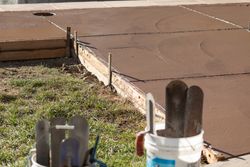
Abrupt temperature changes in Ohio take a toll on paved surfaces—even durable building materials like concrete. Over time, the hot-to-cold swings cause the pavement to crack and break. Here are some steps you and your concrete contractor can take to minimize damage to your concrete.
How to Prevent Concrete Cracks
1. Keep Plants Away
Having shrubs and trees beside concrete pavement may look nice, but you should leave some space between them. Every time you water the plants, the concrete and the soil underneath absorb some of the moisture. Too much water can cause the ground to expand and push against the concrete, eventually creating fissures. Tree roots also continue to force their way through the pavement, creating gaps on the surface.
2. Use Sand Instead of Salt
People are accustomed to using road salt to lower water's freezing point below 32 degrees Fahrenheit and melt the ice. However, this method produces a salt-water mixture that can seep into the pavement. Once temperatures drop below 25 degrees, the water in the concrete refreezes and expands. This continuous freeze-thaw cycle can eventually destroy your pavement. To prevent this, use sand instead of salt. Sand won't melt the snow, but it increases friction and adds traction, making surfaces less slippery.
3. Cure the Concrete Properly
 Curing preserves moisture within the concrete. Without sufficient humidity, the pavement shrinks, compromising the structural integrity of the slab. Ensure the concrete contractors let the material cure for a few days while keeping the surface moist.
Curing preserves moisture within the concrete. Without sufficient humidity, the pavement shrinks, compromising the structural integrity of the slab. Ensure the concrete contractors let the material cure for a few days while keeping the surface moist.
For high-quality concrete paving services, trust the experts at Neyra Paving in Cincinnati, OH. They have more than 50 years of experience providing affordable yet superior concrete and asphalt paving services to commercial and residential clients in southern Ohio and northern Kentucky. The reliable concrete contractors also handle potholes and asphalt repair, parking lot repair, crack sealing, and seal coating. Call (513) 733-1001 to get a free estimate, and visit their website to learn more about their projects.
About the Business
Have a question? Ask the experts!
Send your question

